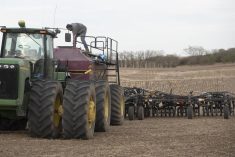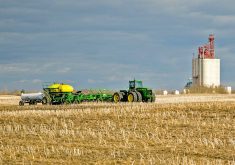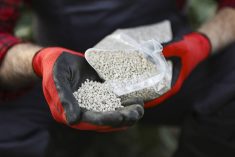Every summer, the perennial question is raised of whether to apply rescue treatment to crops damaged by hail.
And every summer, the question was unanswered. Until now.
At a recent Crop Talk webinar, Manitoba Agriculture soil fertility expert John Heard drew attention to an Alberta study that sought to find an answer.
“I can report today on some fact-based science,” said Heard. “Our brethren in Alberta were funded by the pulse and wheat growers to actually do these studies.”
The study was published in April 2021 in the Canadian Journal of Plant Science. Research was conducted at three locations in Alberta between 2016 and 2018. It looked at the effects of two levels of simulated hail severity at three different crop developmental stages, including the early growth, mid-growth and late growth stages.
Plant growth and yield output for wheat, field peas and dry bean crops were measured.

Hail damage was simulated by whipping chains across the crop foliage to obtain crop defoliation, canopy crushing, and stem and leaf bending and bruising, similar to the effects of a hailstorm. The method was mechanized by attaching a series of short chains to a rotating drum mounted on a front-end loader and driving it over the plots at a controlled height and speed.
Golf balls were added to the ends of chains to mimic damage by hail stones of that size at one research station. Crop adjusters, who regularly assess damage due to hail, assisted with the calibration of hail simulators and assessments of crop damage at each simulated hail severity level.
Lower-severity hail damage reduced wheat yields by 24 per cent, dry bean yields by 17 per cent and pea yields by 37 per cent. For the heavier simulated hail damage, losses of 35 per cent for wheat, 35 per cent for dry beans, and 45 per cent for field peas were observed.
Read Also

Manitoba boosts stake in cereals centre to $23.5 million
Premier Wab Kinew said the additional project funds will help ‘Trump-proof’ the provincial economy.
Hail timing was a critical factor, with hail damage during the early growth stage leading to a less severe yield reduction compared with hail damage at the mid-growth and late growth stages.
The study notes that certain commercial foliar fungicides and nutrient blends have been promoted as being effective recovery tools for hail-affected crops.
“Their application as recovery tools is based on the potential beneficial effects of fungicides and nutrient blends on crop physiology, including stress tolerance, delayed senescence and alteration in the activity of plant hormones and enzymes, in addition to disease control,” it reads.
However, the study indicated there is little to no benefit to applying these treatments after hail damage.
Averaging the hail severity, the timing of the hail and results from all three sites, wheat treated with fungicide yielded 63 bu./ac compared to 62 bu./ac for untreated.
For nutrient treatments, yields decreased to 61 bu./ac. Results were similar for the other crops. Peas treated with fungicide yielded 44.5 bu./ac compared to 44 bu./ac for untreated.
For nutrient treatments, yields decreased to 43.5 bu./ac. and for dry beans treated with fungicide, there was no increase in yield over the untreated control of 32 bu./ac, while treatments with nutrients decreased yield to 31 bu./ac.
The study concluded that foliar application of fungicides and nutrients didn’t aid recovery in any of the damaged crops at any growth stage.
“Applications of fungicides or nutritional supplements to hail-affected crops… are unlikely to provide any benefit to crop recovery or yield, and consequently result in a net economic loss to the producer,” read the report.
“I don’t think anyone ever asks me this question anymore,” said Heard. “We put a nail in that coffin.”
















